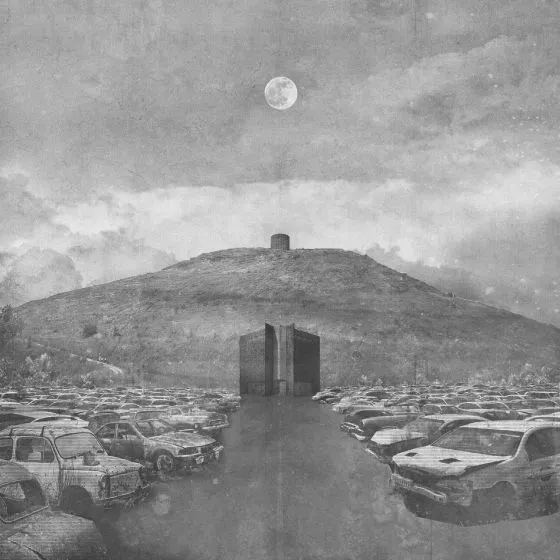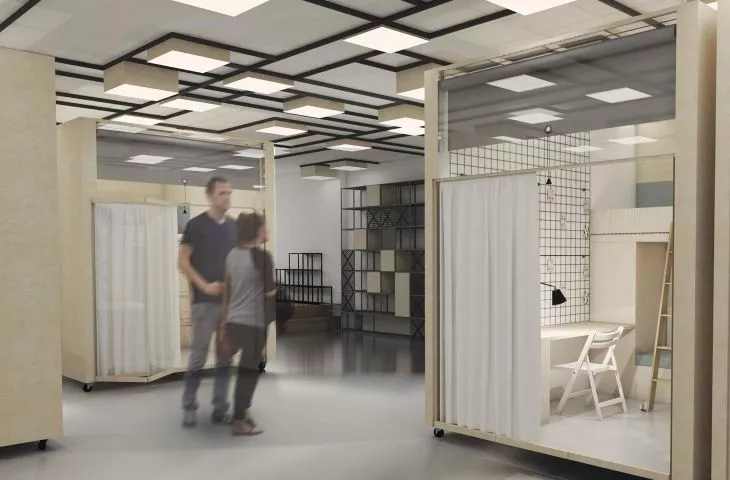Students make up a significant portion of city users, in some centers such as Lublin, Rzeszow and Poznan even twenty-five to thirty-five percent of the total population. Their presence thus has a huge impact on the socio-economic shape of neighborhoods and settlements in Polish cities. Arriving there in search of housing, they also often bring noticeable changes to their immediate surroundings, naturally and bottom-up adapting the conditions of their surroundings to their needs and pursuits.
space for rest and work
© Adrianna Stranc
Over the past three decades, the most popular housing model for incoming students has become renting a room or an entire apartment. Living in a dormitory turned out to be unattractive, the systemic neglect of the transition times led to a significant qualitative degradation of this fabric. To this day, they are associated with narrow and small, ill-equipped rooms. Equally problematic, the rooms are few in number, and university narratives are filled with legends of endless parties and the inconveniences of living in student residences.
The interior of one of the residential modules
© Adrianna Stranc
In reality, however, dormitories are very popular with students, there are fewer units than applicants, and interviews with student housing residents prove that, contrary to popular opinion, the choice of a dormitory is not solely economically motivated; it is often also driven by a desire to experience this period of life in a way that no other form of housing provides. This does not change the fact that the current form of dormitories in Poland raises many aesthetic, functional and ergonomic questions, and does not leave space for students' freedom and creativity. At the same time, for some time now there have been more and more ambitious realizations of private student houses in Poland, which in Western European countries and the United States constitute a significant segment of the real estate market. So it is natural to ask to what extent and what factors - economic, social, cultural - will influence the way modern student houses are designed in Poland. And what should be done to ensure that when forming them today, when the sector is just being born in Poland, we do not make mistakes that will hinder their operation.
The open plan of the dormitory allows for the installation of mobile living modules
© Adrianna Stranc
The author, in asking herself this question, makes a conscious decision to perform an experiment in which she leaves future users free to shape the rules governing spatial relations in the student house themselves. For organizational and technological reasons, the places that require appropriate engineering systems are permanently defined - so the kitchen, sanitary facilities, the space for common recreation and a large table for common work receive their inviolable place. The remaining space, which accounts for almost two-thirds of the project's area, is an open plan with installations mounted from the ceiling above, as well as movable living modules within it, each of which is allocated to one user.
A movable living module done in neutral colors
© Adrianna Stranc
A student living in a dormitory can decide for himself where his module will be located - provided, however, that he respects other users by allowing them to move around the space and access their modules and complementary functions. This situation forces non-standard interactions between users, which can bring clear social benefits. The main reason, however, is the opportunity for students to participate participatively in the process of shaping the spatial layout of the dormitory. They decide how much space they want in the corridors and how they use them. How they want to locate their rooms and arrange relationships between them.
The arrangement of the modules is free
© Adrianna Stranc
A key element of the design is the choice of materials and colors used, which characterize both the movable modules and the common spaces. The author focuses on simple and functional solutions that will have a positive impact on tenants and their well-being. Thus, all the elements specified in the project are based on whites, grays and natural materials, so as to allow users full freedom of behavior and changes made. They do not impose anything, they are a kind of frame in which the "image" of the dormitory created by the students will be located. Thus, the project becomes a tool that widens the field for the social and cultural changes taking place, influencing the creation of social relations only structurally. At the same time, it provokes reflection on temporality, the limits of privacy and the dichotomy between openness and closure.
Adrianna Stranc
Illustrations: © Author









































